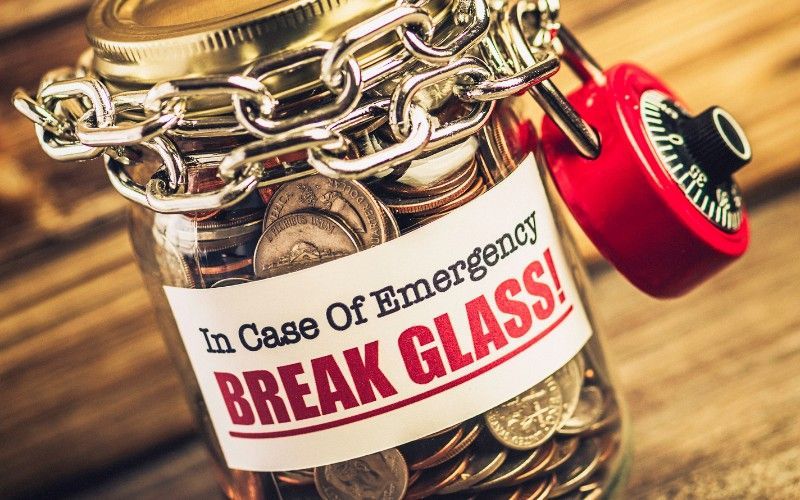Last Updated: July 24, 2024
Securing Your Finances for the Unexpected

Disclaimer: We are not qualified legal or tax professionals and are not giving advice. Always speak with a qualified professional before making any legal or financial decisions.
Life is unpredictable, with sudden medical issues, car breakdowns, and job losses potentially straining our finances. A financial buffer helps navigate these challenges without falling into debt. Building an emergency fund is crucial for your financial well-being, providing a safety net for unforeseen circumstances.
This article will guide you in setting the right savings target and creating a financial safeguard tailored to your needs. Whether you're just starting or enhancing existing savings, these insights will boost your financial confidence.
Understanding Emergency Savings Funds
An emergency savings fund is money set aside specifically to cover unexpected expenses or financial setbacks. An emergency fund can provide a critical buffer when life throws an unexpected curveball, helping you avoid debt or financial crisis.
Some key things to understand about emergency savings funds:
Definition
An emergency fund is a dedicated savings account or pot of money meant to only be used for true emergencies and unplanned costs. It should not be used for discretionary spending.
The Purpose
The purpose of these savings is to provide a financial safety net and cash reserves when urgent, unforeseen expenses pop up. This could include job loss, medical bills, home or auto repairs, family emergencies, and more.
The Benefits
Having some money saved for emergencies means you don't need to use credit cards, or loans, or dip into retirement savings when unexpected things happen. It helps you feel safe and less stressed.
Risks of Not Having a Fund
With emergency savings, any unexpected expense can be financially manageable. You may struggle to pay for basics like food and housing, be forced to take on debt, or make desperate financial choices with long-term consequences.
Common Emergencies
Unexpected expenses like medical bills, job loss, major repairs, emergency travel, or legal fees can derail your finances. An emergency fund helps you weather these financial storms. Building this safety net should be a top priority.
Even a small cushion is better than no savings when a crisis strikes. Read on to learn how to calculate, build, and manage your financial safety net for unexpected events.
Determining Your Emergency Savings Goal
When it comes to an emergency fund, how much should you have saved? Financial experts often recommend having 3-6 months of living expenses available. However, the exact target amount to build an emergency fund depends on your unique situation and other factors in personal finance.
The 3-6 Month Expense Recommendation
Having enough money set aside to cover 3-6 months of your regular ongoing living expenses is a common benchmark for an emergency savings fund. This provides a reasonable buffer to get through periods of unemployment or income loss.
To calculate this amount, add up your essential monthly costs like:
- Housing (rent/mortgage)
- Utilities
- Food
- Transportation
- Insurance
- Minimum debt payments
- Childcare or eldercare
- Other critical expenses
Multiply this by six months of expenses every 3-6 months to get your target emergency savings goal. Of course, the more you can set aside, the more security you'll have. Check out this guide for more on determining the right savings amount for your needs.
Setting Incremental Savings Goals
Don't be overwhelmed by the total amount needed. Start small, aiming for one month of expenses, then build up gradually. As your emergency fund grows, you'll gain financial security. Track these milestones to stay motivated. Over time, you'll confidently accumulate a cushion for unexpected situations.
Adjusting Goals Over Time
Review your emergency fund target annually. Changes in living expenses may require adjusting your savings rate. Major life events, like having a child or buying a home, can increase monthly costs and necessitate a higher savings threshold. As your financial situation evolves, adjust your goals accordingly.
A clear, personalized target tailored to your unique finances sets you up for success. Let's explore how to start saving, contributing, and building your financial safety net effectively.
Making Regular Contributions
Building your emergency savings requires making consistent, ongoing contributions to get into the habit and grow your fund over time.
Here are some tips:
Create a Savings Habit
Set up a separate account for your emergency fund with automatic transfers from your checking account. Consistently save a set amount to build your emergency fund, whether weekly, monthly, or per paycheck. Even small, regular contributions will accumulate over time. Automating this process ensures your savings grow steadily, providing a financial safety net for unexpected expenses.
Take Advantage of Windfalls
Use cash gifts or unexpected income like tax refunds, work bonuses, or gift money to boost your emergency fund's savings. Have the cash or money directly deposited into savings.
Split Direct Deposits
Ask your employer about dividing your paycheck between a checking account and savings account direct deposit. This automatic high-yield savings account direct deposit will grow your fund painlessly.
Save First, Spend Second
Prioritize savings in your budget. Transfer a contribution to your emergency fund from each paycheck before allocating the rest for expenses. This "pay yourself first" approach keeps saving on track.
With effort and creativity, anyone can find ways to save automatically and consistently build their financial safety net over time. The key is making it a habit through any means necessary.
Choosing Where to Keep Your Emergency Savings
When building your emergency fund, it's important to keep the money somewhere safe yet accessible.
Here are some of the best places to park your savings:
High-Yield Savings Accounts
Savings accounts at banks or credit unions are ideal for emergency funds. Your money is secure, earns interest, and can be withdrawn easily. Choose an account with no minimum balance and a competitive interest rate.
Money Market Accounts
Money market accounts function similarly to savings accounts but may earn slightly higher interest rates. This account can help your money market funds to grow faster while staying protected.
Certificates of deposit (CDs)
CDs offer higher interest rates but lack flexibility, making them less suitable for immediate needs. Instead, keep your emergency fund in a liquid, federally insured account separate from everyday spending. Ensure it's easily accessible without penalties.
Using Your Emergency Fund Wisely
When an unexpected expense arises, it can be tempting to dip into your emergency savings. But you'll want to exercise restraint and only use the funds for true emergencies.
Here are some reminders:
- Define what constitutes an emergency in your mind, like job loss, medical needs, housing costs, or safety issues. Don't use the money lightly.
- Avoid the temptation to spend emergency savings on non-essential purchases, vacations, or splurges no matter how appealing. Remind yourself that this money has a specific purpose.
- When forced to use the funds, revisit your budget and look for expenses to cut back on to extend the lifespan of your remaining savings. Temporarily reducing spending where possible can help. Check out these budget-cut tips for ideas.
- Remember that the emergency fund is for short-term urgent needs, not long-term or recurring expenses. Use it judiciously as a last resort only when necessary.
Having a plan and discipline around emergency fund use is just as important as diligently saving the money in the first place. Use it as a serious financial security blanket, not a piggy bank, to get the most value.
Replenishing Your Savings
Despite your best efforts, you may experience an emergency that necessitates digging into your savings fund from time to time. When this happens, it's important to get your cash flow back on track and replenish what was used as quickly as possible.
Here are some tips:
- Strive to continue making your regular emergency fund contributions, even if you need to use the money. This will help you rebuild faster.
- Put any extra windfall money like bonuses, tax refunds, or gifts towards topping back up your savings.
- Look for opportunities to earn supplemental income through a side gig that can be contributed to your fund.
- See if you can increase your regular automated savings contribution to expedite replenishing the fund. Even small increments help.
- Cut back discretionary spending temporarily until the emergency fund is back to your target amount. Be diligent.
- Consider it a fresh start rather than a setback. Recommit to your new savings goals and habits.
Rebuilding your emergency cushion quickly after using the money is critical. Be patient with yourself but focused, and treat savings contributions like any other must-pay bill. Consistency over time is key.
Balancing Savings and Debt Repayment
When managing personal finances, a common dilemma is whether to prioritize building an emergency fund or paying down debt. Both goals have merit, and there are reasonable arguments for each approach. The right balance often depends on your financial situation and goals.
Here are some tips for finding the right balance:
Pros of Prioritizing Debt Repayment
- Paying off high-interest debt avoids the accumulation of more interest fees and minimizes total interest paid over time.
- Eliminating debt frees up more cash flow for other goals like savings.
- Mathematicians argue paying down debt provides a better guaranteed "return" than typical savings interest rates.
Pros of Prioritizing Emergency Savings
- Having cash reserves prevents taking on new debt in the event of an emergency.
- Psychological benefits like reduced stress and increased financial confidence.
- Flexibility to handle unexpected expenses without disrupting long-term financial plans.
Suggested Balancing Tips
- If you have high-interest debt (e.g. credit cards), pay more than minimums and attack that first. But still save something, even if small.
- If debt is low or zero interest (e.g. student loans), prioritize building emergency savings while making minimum payments.
- Split discretionary income between debt repayment and savings goals to make steady progress in both areas.
- As debt shrinks over time, increase emergency fund contributions with money freed up.
- Re-evaluate priorities as income or expenses change. Remain flexible.
With some planning and discipline, you can chip away at debt while simultaneously building your rainy-day fund one-day reserves. Check out this guide for more tips on balancing savings and debt repayment. The right approach depends on your unique financial situation.
FAQs
Conclusion
An emergency fund is crucial for handling unforeseen challenges like job losses or medical emergencies. Aim to save 3-6 months of living expenses. Use automated transfers and regular contributions to build your fund over time. Even small amounts help. Start today to better prepare for life's financial surprises and gain peace of mind.
For those seeking additional insights and resources on financial readiness and consumer rights, the Consumer Financial Protection Bureau (CFPB) is an invaluable resource. The CFPB is a U.S. government group that makes sure banks and other money places treat people fairly. They have lots of helpful information to help you with your money decisions.
If you are struggling with overwhelming debt and want to explore your personal finance relief program options, Pacific Debt Relief offers a free consultation to assess your financial situation. Our debt specialists can provide objective guidance and assistance to help find the right debt relief program and solution.
*Disclaimer: Pacific Debt Relief explicitly states that it is not a credit repair organization, and its program does not aim to improve individuals' credit scores. The information provided here is intended solely for educational purposes, aiding consumers in making informed decisions regarding credit and debt matters. The content herein does not constitute legal or financial advice. Pacific Debt Relief strongly advises individuals to seek the counsel of qualified professionals before undertaking any legal or financial actions.
✔ Accredited by Better Business Bureau with BBB A+ rating (4.93 rating and 1678 reviews)
✔ US News and World Reports and Bankrate ranked Pacific Debt Relief as one of “The Best Debt Relief Companies of 2024”
✔ 6.9 star rating by BestCompany.com (over 2379 client reviews)
✔ 4.8 star rating by TrustPilot based (over 1613 verified consumer reviews)
✔ ConsumerAffairs.com Accredited (over 544 verified reviews with an average rating of 5 stars)
✔ A Top 10 Rated Compan by TopTenReviews.com , ConsumersAdvocate.com and Top10debtconsolidation.com
✔ 4.6 star rating by Google (229 client reviews)
✔ 100% rating by SuperMoney (9 client reviews)
Reduce Your Credit Card Debt By Up to Half

BBB Reviews | 4.9/5.0 Rating









 Do Not Sell My Personal Information
Do Not Sell My Personal Information